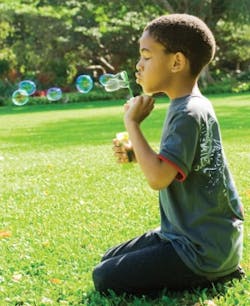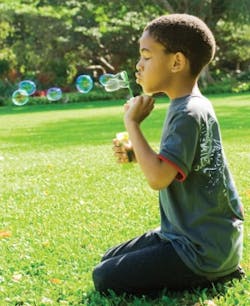Air Polishers
Innovations in product designs also enhance safety
by Cathy Hester Seckman, RDH
Children and air polishers might not be two things you'd think of putting together. If you've ever tried to use an air polisher to blast two days' worth of plaque from the orthodontic brackets of a fussy, overly dramatic teenage girl, you know what I mean. The first time I tried using an air polisher for such a teen, there was Oscar-worthy trauma.
"Ewww, ewww, Mom, you'll never guess what she did!" the girl wailed, escaping my chair to burst into a full waiting room. "She sprayed this, like, salty stuff in my mouth and it went everywhere; oh, Mommy, ewww, it was so awful!"
Air polishers have come a long way since then. I have, too. Back then, air polishers were messy and unpleasant, and there was only one way to use them - full power, full blast. They clogged easily, and the powder was a salty sodium bicarbonate that many adults disliked and many children hated. Back then, I didn't know enough to shield the patient and myself from overspray.
The market today includes many choices with many options. The venerable Cavitron Prophy-Jet can be used with either sodium or non-sodium powder. It also has two modes available - polishing and rinsing. In addition, the Cavitron Jet Plus features a 330-degree swivel and fingertip lavage control for its Jet-Mate handpiece.
KaVo offers the portable ProphyFlex 3, which attaches to a MultiFlex coupler. Air carries the powder to the tip of the handpiece, where it is surrounded by water as it exits the tip. The handpiece has a 360-degree swivel, is lighter and shorter than the previous model, and comes with two sterilizable tips. The ProphyFlex 3 can be used with traditional sodium bicarbonate powder, or with the new KaVo calcium carbonate Prophy Pearls powder. Because Prophy Pearls are round, say the manufacturers, they have infinite contact points with the tooth surface and can be directed at a shallow working angle for more cleaning power.
The Acteon AirMax, Prophy Max Newtron, and Prophy Max Newtron Lux, offered by the makers of Satelec, also polish after scaling, or during periodontal and implant maintenance.
Electro Medical Systems (EMS) has recently introduced the Air-Flow Perio technology that promises to remove bifoilm from periodontal pockets in five seconds. Their glycerine-based powder is said to have one-fifth the abrasiveness of sodium bicarbonate. Reduced air pressure, EMS says, allows for safe application of the air-powder-water mixture into the pocket, and the resulting biokinetic energy of the mixture removes biofilm. The Perio-Flow nozzle has three horizontal outlets for air and powder, and one vertical outlet for water to optimize the mixture in the pocket and prevent soft tissue damage.
The Air-Flow Perio method is available in a tabletop device, or as a portable device that attaches to a high-speed handpiece.
Another option is the Sylc SmarTip from OSSpray. Their waterless SmarTip unit can be attached directly to a dental handpiece air source with a four-hole adapter connection. Since the tip does not need water, it adapts very easily to a typical hygiene setup.
The SmarTip was designed for use with Sylc therapeutic prophy powder, though the powder can also be used with any air polishing system. Sylc is full strength calcium sodium phosphosilicate, or bioactive glass, which is NovaMin. Although there is still 450 mg sodium in NovaMin, it is much less than the 2,000 to 3,000 mg found in sodium bicarbonate. It's released over time, so there is no salty taste.
NovaMin has been shown to have desensitizing and remineralizing properties. A study done at the London Dental Institute in 2009 showed that bioactive glass is a more effective desensitizer than sodium bicarbonate in both good and poor oral hygiene groups. Sauro et al. concluded that bioactive glass is suitable for treatment of dentinal hypersensitivity because it creates a dentin surface resistant to citric acid attack.1 Another study, done this year in London, found that bioactive glass powder had a significant longer term desensitizing effect, while sodium bicarbonate powders tended to increase sensitivity in the dentin.2
The benefits of air polishing for adult patients are well-known. Biofilm removal, cleaning around implants, and easy erasure of even the most difficult tobacco stain are all reasons to appreciate air polishing. But don't forget they can also be a good adjunct for pediatric oral health care. The American Journal of Orthodontics and Dentofacial Orthopedics reported as far back as 1993 that air-powder polishers were "the most effective method of plaque removal for orthodontic patients without causing breakage of elastics or wires or loss of zinc phosphate or composite material." Another application, the journal pointed out, is tooth surface preparation before bracket placement.3
Sealant placement can also benefit from air polishing, according to the department of dentistry at the University of Rome. In a study published this year, researchers studied the efficacy of clearing plaque from pits and fissures with disclosing solution and either synthetic bristles or air polishers. The conclusion of the study was that "pits and fissures should be cleaned with a plaque indicator and air polishers before placing a sealing material to ensure complete removal of plaque from the tooth."4
Dr. Gordon Christensen has advocated the use of an air polisher prior to DIAGNOdent use. The diode laser beam of the DIAGNOdent, Christensen says, can be blocked by stain or calculus.5
Air polishers and respiratory safety?
The material safety data sheets for air polishing powders do not list any significant hazards. Sylc powder is not absorbed through the skin, and shows no contraindications for use unless the powder is inhaled in "very large quantities."6 The MSDS for Prophy Pearls shows the only toxic effects of the powder are those similar to other dust nuisances, such as irritation to the respiratory tract. In rare cases, skin contact with the powder may cause irritation. When handled properly, the MSDS states, "the product has no harmful effect according to our experience and the information available to us." The MSDS for Young's brand of air polishing powder states there are no known health hazards associated with it. The material is nontoxic if swallowed, but may cause slight transient eye irritation with contact. No air polishing powder should be used if there is a silica allergy.
Studies done on air quality in dental operatories do not specifically look at air polishers. The focus is on all airborne contaminants, including those from dental unit waterlines. A study published in the Journal of Occupational and Environmental Hygiene in February 2009, for example, looked at measurements of airborne bacteria and endotoxins during dental cleanings. It was found that dental staff and patients were exposed to up to 1.86 E+05 bacteria/m(3) during treatment. Air quality returned to baseline measurement within two hours. The small diameter of the aerosols generated (<1 micron) suggests that contact between the aerosolized bacteria and the respiratory system of exposed individuals is likely to occur.6Harrel and Molinari at Baylor College of Dentistry in Dallas conducted a 2004 review of aerosols and splatter in dentistry and their infection control implications. After reviewing medical and dental literature on contamination and the spread of disease through an airborne route, they recommended a layering of infection control steps. "In addition to the routine use of standard barriers such as masks and gloves," the review stated, "the universal use of preprocedural rinses and high-volume evacuation is recommended."7 A hygienist working alone, don't forget, can use a Blue Boa to adapt a hands-free, low-volume suction tip to a high-volume evacuation hose.
Scientists at the University of Bologna, Italy, compared the efficacy of three types of face masks in preventing inhalation of airborne contaminants in dental practice. A personal particulate respirator mask provided the best protection with an efficacy of 94 to 98%. A molded surgical mask had an efficacy of 90 to 92%; a tie-on surgical mask had an efficacy of 85 to 88%.8
While we're protecting ourselves, let's not forget the patient. Crosstex offers a patient safety mask that covers the nose and eyes very neatly.
With, as Harrel and Molinari suggest, multiple layers of infection control procedures, and with the best available PPE in place for both hygienist and patient, we can feel more confident about taking advantage of the opportunities an air polisher system affords for high-quality patient care.
Cathy Hester Seckman, RDH, is a frequent contributor based in Calcutta, Ohio. Besides working in a pediatric dental practice, Seckman is a prolific freelance writer, a book indexer, and a speaker on dental and writing/indexing topics. She can be reached at [email protected].
References- Sauro S, Watson TF, Thompson I. Dentine desensitization induced by prophylactic and air polishing procedures: An in vitro dentine permeability and confocal microscopy study. J Dent 2010, 38: 411-422.
- Banerjee A, Hajatdoost-Sani M, Farrell S, Thomson, I. A clinical evaluation and comparison of bioactive glass and sodium bicarbonate air-polishing powders. J Dent 2010; 38(6):475-479.
- Gerbo LR, Barnes CM, Leinfelder KF. Applications of the air-powder polisher in clinical orthodontics. Am J Orthod Dentofacial Orthop Jan 1993, 103(1): 71-73.
- Botti RH, Bossu M, Zallocco N, Vestri A, Polimeni A. Effectiveness of plaque indicators and air polishing for the sealing of pits and fissures. Eur J Paediatr Dent March 2010, 11(1): 15-18.
- http://www.dentaleconomics.com/index/display/article-display/6852030618/articles/dental-economics/volume-100/issue-6/columns/ask-dr__christensen.html Accessed Aug. 23, 2010
- Harrel SK, Molinari J. Aerosols and splatter in dentistry: a brief review of the literature and infection control implications. J Am Dent Assoc. April 2004, 135(4):429-37.
- Dutil S, Meriaux A, de Latremoille MC, Lazure L, Barbeau J, Duchaine C. Measurement of airborne bacteria and endotoxin generated during dental cleaning. J Occup Environ Hyg Feb. 2009, 6(2): 121-130.
- Checchi L, Montevecchi M, Moreschi A, Graziosi F, Taddei P, Violante FS; Efficacy of three face masks in preventing inhalation of airborne contaminants in dental practice. J Am Dent Assoc July 2005, 136(7):877-882.

